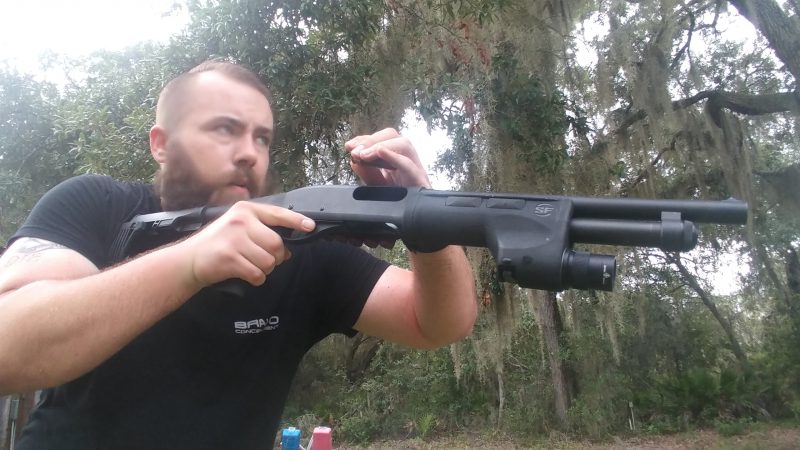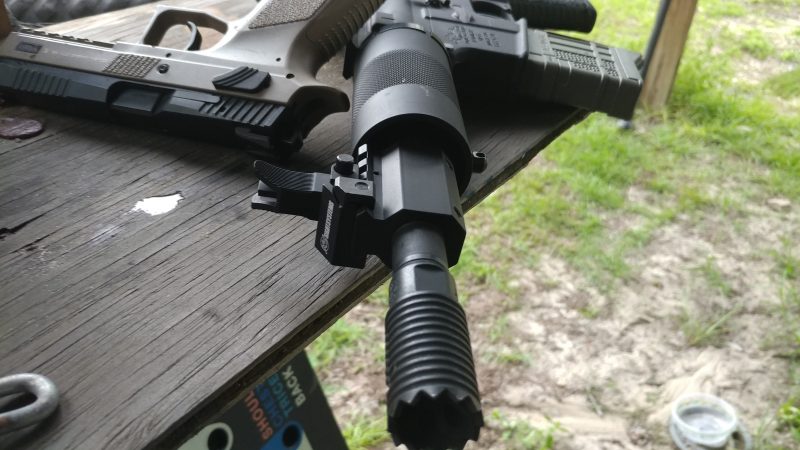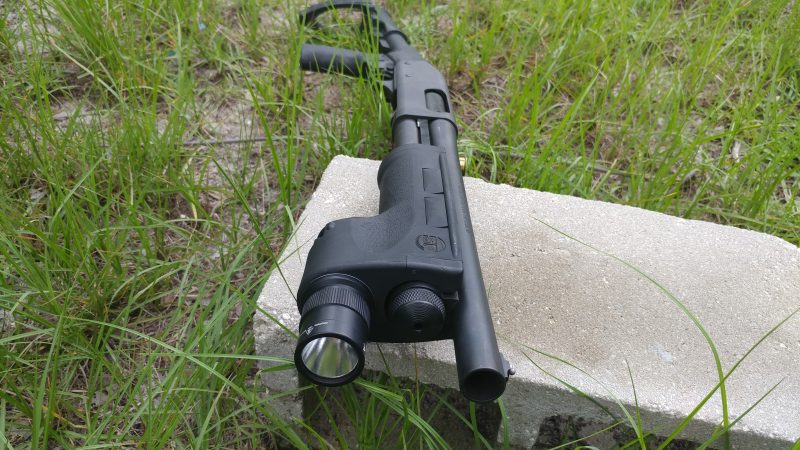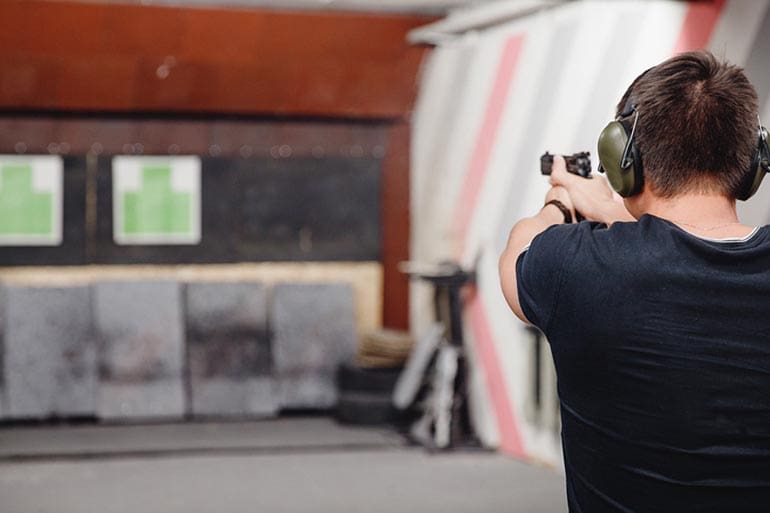Firearms drills are an absolute blast. They sharpen your skills, give you a challenge at the range and can change the way you think about shooting and self-defense. They can also be an eye-opener, and a means to evaluate your skills. So without further distraction, here are my five favorite firearms training drills.
The El Presidente
The El Presidente is a classic firearms training drill created by Jeff Cooper. The exercise utilizes three targets, a handgun, a holster, a shot timer, and an extra magazine and magazine pouch. The three targets should be man-shaped with the vital area clearly marked.
The targets should be placed one meter from each other. Load two magazines with six rounds each.

How to Shoot It
You start ten yards from the targets facing away from them. You hands are held above your head as if you are surrendering. At the go buzzer you turn, draw from concealment and engage each target twice. After shooting six rounds, your gun should be dry. Reload, and engage each target with rounds again. A perfect score is 12 shots across 3 targets all in the vital region in ten seconds is a passing score.
What it Trains
The El Presidente drill trains a wide variety of different skills. It teaches essentially every fundamental handgun combat skill out there. It trains your ability to draw from concealment, to move and shoot, as well as proper shot placement, and reloading. The drill sounds easy, but its very easy to toss a shot out of the vital zone, and even harder to hit that ten second time. It’s the best kind of stressful in my opinion.
The 1-5X Drill
The 1-5X drill was created by Kyle Lamb of Viking Tactics and is designed around the tactical carbine. That being said the exercise can be done with a handgun. You’ll need a rifle, a single magazine loaded with 15 rounds, and 3 targets placed 1 meter apart.

How to Shoot It
Start five yards away from the three targets. The drill requires IPSC targets, but any man-sized targets will work. You’ll want to aim for the vital zones of a target. You can work from left to right or right to left. If you do the drill more than once mix it up a bit. Starting on the first target fire a single round, transition to target 2 and fire two rounds, transition to target 3 and fire three shots.
You aren’t done yet though. Keep the momentum going and transition back to target 2 and fire four rounds. And to finish the drill transition to target 1 and fire five shots. Try to complete this drill in under five seconds.
What it Trains
It trains rapid transitions and for you to drive your gun from target to target. It also doesn’t allow you to fall into the trap on firing one or two rounds on target and ending the drill. You get your time down you need to learn a degree of riflery skills. This includes trigger control, body positioning, and recoil and muzzle control.
Port Reload – Shotgun
The Port Reload Drill is very simple, but a very important skill to master. A shotgun’s biggest weakness is its low capacity. It’s critical any shotgun operator learns how to reload their weapon effectively. The port reload drill trains shooters to quickly and effectively load an empty shotgun with just one more round. You’ll need a shotgun, a method to hold ammo (side saddle is best), two targets, and two shots per drill.

How to Shoot
Start at 10 yards with a round in the chamber, but an overall empty shotgun. The two targets should be one meter apart. Fire one the first target and keep the bolt to the rear. Keep your shotgun pointed down range and with your non-firing hand retrieve a round of ammunition. Load the round directly through the port and close the bolt. Engage the second target. The drill should be done in about 2 seconds total with a side saddle ammo carrier.
What it Trains
Your ability to quickly reload and re-engage a target is the primary purpose of this drill. It helps build reloading into a habit, and the faster you reload the shotgun, the deadlier you will be. You’ll gain a better understanding of the shotgun’s manual of arms, as well as what makes a shotgun tick.

Mozambique or Failure Drill
The Mozambique drill is a classic drill that Jeff Cooper advocated. Mike Rousseau essentially invented the drill in an actual firefight. The exercise is all about proper shot placement and covering your butt. It’s one of those drills that ensure you get the job done when the fight starts.
The Mozambique drill is perfect for beginners and experts to learn and exercise with. You need a handgun or rifle, three rounds, one magazine, and one target. If using a handgun you need a holster.

How To Shoot It
You can start at essentially any range, although the drill is for close quarter’s use so let’s start it at 10 yards or less. The exercise begins with the gun holstered or at the low ready, loaded with at least 3 rounds. On the go signal, draw the gun and fire two rounds to the chest immediately transition and place one well-aimed shot to the head. Your goal should be to do this in under 2.5 seconds, and even under 2 seconds is possible.

What it Trains
Obviously, it’s going to train your ability to draw your firearm rapidly. On top of that, you’ll be learning about shot placement and forming an excellent set of skills for getting proper shot placement regardless of the situation. You’ll learn to transition from chest to head with confidence.
F.A.S.T. Drill
The F.A.S.T. drill which is short for Fundamentals, Accuracy, and Speed Test is one helluva hard drill to master, but when you do you’ll be a competent shooter. The Drill requires you to have one target, a 3×5 card, an 8-inch paper plate as well as a target backer.
You’ll need two magazines, one loaded with 2 rounds and one loaded with 4 rounds. You’ll also need a mag pouch, a holster, and a shot timer. If you are not using a retention holster, you must fire the drill from concealment.

How to Shoot It
The drill is done at seven yards with the handgun holstered and one in the chamber. The plate is set on the torso of the target, and the 3×5 card is placed on the head. At the start signal, you draw, and fire two rounds into the head of the target, then perform a slide lock reload with the spare magazine. Fire the 4 shots into the plate.
If you miss, you fail. Take your time with this drill and go for accuracy over speed. Speed comes with time. However, speed is how you judge your skill as a shooter. There are four rankings for this drill.
10+ seconds: Novice
less than 10 seconds: Intermediate
less than 7 seconds: Advanced
less than 5 seconds: Expert
It’s a tough drill but is a good way to learn and test skills. The target can be found here and can be printed at home.

What it Trains
Speed and accuracy, the two most important skills a self-defense shooter can have. You’ll also develop the ability to draw and get onto a relatively small target quite quickly. There is also an established time and accuracy standard which gives you realistic goals to hit.
Getting Drilled
Drills are an excellent way to build your skills and test yourself. They shake up a normal range trip and can help you hone those skills to a razor’s edge. Also, they happen to be challenging and a lot of fun, too. Put a few of these into your training rotation and let us know how they flow.





Well a person could do all that or they could drive to Chicago.
Targets don’t shoot back. Chiraq’ez on the other hand.
None of the ranges around me would allow such things.
Thats sad.
Do they not allow shotguns? That one should be tame enough.
I never heard of the El Presidente limiting the number of rounds in the magazines. You would not download your carry magazines on the street. The exercise does require a reload after six rounds.
In addition, Cooper specified the El Presidente be shot from concealed carry.
I don’t recall seeing a start position for the rifle drill. Low ready? Mounted to shoulder?
Low or high ready on the rifle drill. As you prefer.
Revolver with NY reload?
Why no Bill Drill?
If you don’t have snap caps or dummy rounds for dry fire practice you are wrong. I prefer snap caps because there are different color compared to real ammunition brass.
I can just see going to any range near me and trying to set up several targets a meter apart from each other. And hell no being able to draw from a holster.
Quickdraw McGraw has a limp, is the way I heard it, way back when.
In other words, practicing fast draw should done with an empty chamber.
Live fire starts low ready…
Tell that to the 40,000 or so people shooting USPSA every weekend.
As long as all 4(5)safety rules are followed, no issues at all. Shooting Sports are the safest sport to participate in…..
Literally any USPSA classifier . . . .
Travis, not sure if you’ll see this, but a short time ago I secured a S&W model 1917. with original US brown leather army holster. You wrote an review on the 1917 not long ago. I was envious and said so. Yesterday Providence fell in my my lap. I got a PX. This revolver is 90 percent. Manufactured April/May 1918. Guessing no real time in the trenches. Long live those of us that appreciate what is well made.
Comments are closed.